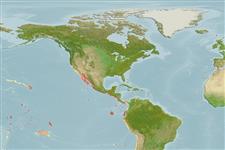Common names from other countries
Environment: milieu / climate zone / depth range / distribution range
Ecologia
marinhas associadas(os) a recifes; intervalo de profundidade 3 - 60 m (Ref. 91172). Subtropical; 38°N - 30°S, 180°W - 70°W
Eastern Pacific from northern California to Chile and Hawaiian Islands; including the Galapagos Islands.
Tamanho / Peso / Idade
Maturity: Lm ? range ? - ? cm
Max length : 76.0 cm TL macho/indeterminado; (Ref. 2850); common length : 50.0 cm TL macho/indeterminado; (Ref. 9276)
Body compressed and deep; skin thick, with large, rectilinear, plate-like scales that are easily visible to the naked eye; mouth small; teeth strong and protruding, 8 in each jaw; dorsal fin with 3 spines and 26 to 28 rays; scales behind the gill openings larger than the neighboring scales; snout surrounded by scales (Ref. 55763).
Occurs in rocky reefs, boulder strewn slopes and adjacent areas of sand. Adults demersal; young pelagic (Ref. 2850). Feeds on sea urchins, small crustaceans and mollusks (Ref. 5227). Minimum depth 3m (Ref. 116844).
Life cycle and mating behavior
Maturidade | Reprodução | Desova | Ovos | Fecundidade | Larvas
Eschmeyer, W.N., E.S. Herald and H. Hammann, 1983. A field guide to Pacific coast fishes of North America. Boston (MA, USA): Houghton Mifflin Company. xii+336 p. (Ref. 2850)
Categoria na Lista Vermelha da IUCN (Ref. 130435)
CITES (Ref. 128078)
Not Evaluated
Ameaça para o homem
Harmless
Utilização humana
Pescarias: espécies comerciais
Mais informação
ReferênciasAquaculturaPerfil para aquaculturaEstirpesGenéticaElectrophoresesHereditariedadeDoençasProcessamentoMass conversion
Ferramentas
Relatórios especiais
Descarregue XML
Fontes da internet
Estimates based on models
Preferred temperature (Ref.
115969): 19.2 - 28.9, mean 25.8 (based on 76 cells).
Phylogenetic diversity index (Ref.
82804): PD
50 = 0.5078 [Uniqueness, from 0.5 = low to 2.0 = high].
Bayesian length-weight: a=0.02630 (0.01678 - 0.04123), b=2.85 (2.72 - 2.98), in cm Total Length, based on LWR estimates for this species & (Sub)family-body (Ref.
93245).
Nível Trófico (Ref.
69278): 3.3 ±0.37 se; based on food items.
Resiliência (Ref.
120179): Baixo, tempo mínimo de duplicação da população 4,5 - 14 anos (Preliminary K or Fecundity.).
Fishing Vulnerability (Ref.
59153): Moderate to high vulnerability (54 of 100).
